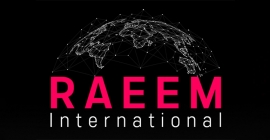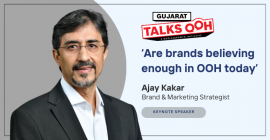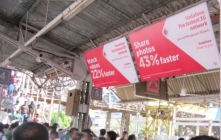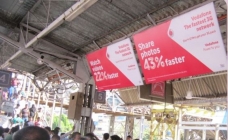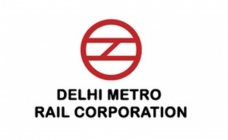‘If done right, audience data will deliver a major multiplier of investment to OOH media’
By Rajiv Raghunath - October 20, 2020
Srikanth Ramachandran, Founder & Group CEO of Moving Walls asserts that in the new normal post Covid-19, planning and campaign inflight/post-campaign reporting are becoming vitally important for OOH
Data is the new oil. A little over a decade ago when British mathematician and data scientist Clive Humbley extolled the virtues of data science in business, few took note of the imperative of gearing up for a data-driven business environment, least of all OOH. Today, data is fundamental to the advertising business, and there is a strong felt need for Indian OOH to embrace data analytics in a big way, especially in regard to audience data. Srikanth Ramachandran, Founder and Group CEO of Moving Walls, shares his perspectives on audience metrics that will increasingly shape the contours of Indian OOH landscape.
Moving Walls, a media technology group with a presence across four continents and seven markets, is assiduously developing and promoting data technologies for OOH. The company operates Moving Audiences, a patented multi-sensor approach to location-based media measurement. Today, Moving Walls processes more than 10 billion data points and measures more than 35,000 media sites across the globe. Through measuring physical locations and people movement, this powers Planning, Buying, Verification, and Content Delivery capabilities for location-based media like billboards, digital signage, and transit media. Edited excerpts of the interview with Rajiv Raghunath:
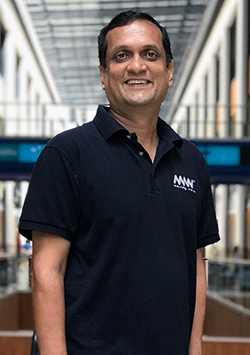 How data-driven OOH advertising will induce brands and agencies to put more ad dollars on OOH?
How data-driven OOH advertising will induce brands and agencies to put more ad dollars on OOH?
There is a famous saying that history repeats itself. We need to look back a decade and see how digital has grown from nowhere to accounting for 40%-55% of marketing spends in almost all markets globally. We believe addressable audiences and automation were the two major reasons why they attracted marketing budgets. Applying the same to outdoor, we believe OOH can achieve the same growth with addressable audiences data.
While brands continue to invest significantly in digital marketing, the incremental investment in this media has started plateauing out. The reason for this is that as a stand-alone medium, digital has a point of diminishing returns, after which its ability to impact consumer behaviour drops. OOH has an opportunity to step in and become central to all marketing campaigns. If done right, audience data will deliver not just a minor increment, but a major multiplier of investment to OOH media.
What steps will facilitate accelerated adoption of OOH audience data tools for planning?
The market is in early stages where education will be the most important step that everyone in the industry needs to focus on. Moving Walls is working with more than 100 media owners across Asia to digitise their business. Working in a collaborative model enables media owners to provide common metrics and brings confidence to outcome-driven marketers.
However, the focus needs to go beyond planning datasets. In some markets where planning datasets at an industry level exists, Covid-19 has brought up the need for campaign inflight reporting - i.e., tracking of campaign performance on a near real-time basis. So, in the new normal post Covid-19, planning and campaign inflight/post-campaign reporting are becoming important.
From our perspective, we have been working with agencies and clients to build proof points for planning and campaign inflight/post-campaign reporting. Though the pandemic has set back the timelines, overall we have done close to 150 data-driven planning and/or post -campaign measurements for over 40 clients/agencies in India, processing data from around 20,000 OOH sites across the country.
We utilised the downtime caused by the pandemic to ramp up our engagement with media agencies, clients and media owners. We conducted over 30 webinars which were attended by over 500 participants from the industry, educating them on the benefits of an automated, metrics driven approach to OOH advertising.
What are the current barriers, and how they can be overcome?
Industry level consensus and the vision and willingness to make the investments is crucial. In other markets like Singapore, we have seen a willingness from all stakeholders -- agencies, media owners and marketers -- to join hands and set a common standard. Where the market still remains fragmented, every stakeholder in the value chain will claim to have its own measurement metrics and understanding of OOH. This leads to lack of standard industry metrics, creating transparency and trust issues on the media itself.
We are at a crossroads right now. The OOH media industry has been hammered badly due to the ‘work from home’ implementation. As we emerge into a new normal, we will still spend an average of 2-3 hours daily outside our homes. We can continue to bury our heads into the sand or use this opportunity to ask a simple question -- When the Internet reach is around 50% and the addressable time is 2-3 hours, why is there a media inequality with 10x spends on Internet related media? But to ask this question, we need addressable audience data in OOH and we need to have an industry standard that provides the confidence to advertisers that we are asking the right questions.
With multiple agencies developing audience data tools, will Indian OOH see a common currency for audience metrics coming about?
We are not alone in this world and we can learn from what is happening in the rest of the world. A common currency at industry level provides the much needed confidence for advertisers to spend their budgets on OOH media. The common currency should be established in collaboration with a technology provider who does not have any vested interest in media and/or agency.
A common currency does not imply that agencies should not develop tools that differentiate their services. Instead, with such a standard in place, the agencies have a wonderful opportunity to create an omni-channel understanding of priming and activation leading to improved return on investment to the advertisers. They can even integrate OOH to first party location and/or audiences data held by the advertisers and optimise plans specific to each of these advertisers.

Stay on top of OOH media trends

_140_270.png)
